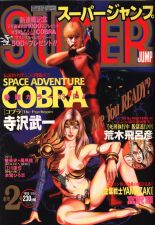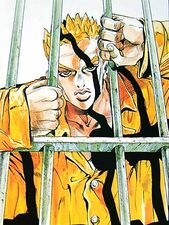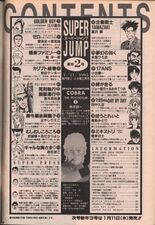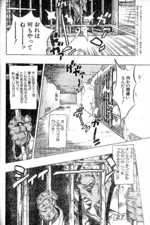Under Execution, Under Jailbreak
The story follows a prisoner who is convicted of murder and sentenced to death, but discovers that his bizarre holding cell is the execution chamber itself—and that it may hold the key to his freedom.
Summary
An unnamed defendant at court, known only as Prisoner 27, is ordered to rise. He has been found guilty of murder, and so the court sentences him to death. The criminal is taken to prison to await his execution, all the while pleading his innocence.
As he readily admits in narration, he is lying through his teeth. While lying in his bed one night, he noticed that he was missing some money. He asked the girl who was with him for an explanation, but she claimed to know nothing about it. He would have been more than willing to forgive the theft, having himself committed theft several times. To him, however, being lied to is a sign of complete disrespect, and he harbors a deep hatred for liars, despite being one himself. That is his motive for bashing the girl's skull in, sixteen or seventeen times.
The prisoner suddenly notices that his cell is too dark to see into, and realizes that his cell has a light switch. He turns the light on, but is suddenly stung by a group of bees from a beehive beneath the light switch. Though he tries to cry for help, no one comes to his aid. With the lights on, the cell is revealed to be fully furnished, and the prisoner thinks it more comfortable than his own apartment. A meal of fried fish, soup, and bread has even been left on the table for him. The prisoner attempts to eat, but finds that his spork is full of holes. When he decides to eat the fish using his bare hands, the fish's sharp bones burst out as soon as he bites into it, stabbing him in the face. He falls back in shock, but his chair collapses, further impaling him with its pieces.
Believing that the guards are playing a prank on him, he angrily throws his useless spork at the wall, but sees that the wall is damaged by it. Ecstatic at the opportunity to escape, he attempts to dig further with the utensil, but this is soon revealed to be a trap as well. Two of the prisoner's fingers on his right hand are severed clean by a meat grinder hidden just beyond the wall, with the rest of his hand severely damaged. The prisoner finally realizes that his cell is no normal cell, and that he is already under execution.
The prisoner falls onto the floor, where he finds nails rising from the floorboards. The nails snag his clothes as an acidic solution begins to leak from the holes beneath. Ditching his shirt, the prisoner leaps onto the sofa, only to be entangled by wires as the cushions tear off. A group of four mice pull on a piece of meat attached to a switch, revealing the sofa to be an electric chair. Unable to untangle himself from the wires, he barely escapes death by electrocution by breaking the remaining three fingers on his right hand and offering them to the mice. With only one mouse left to pull on the switch, he manages to get free of the wires just before the switch is flipped. The chair then explodes, killing the mice and breaching the cell wall, creating a small hole where sunlight shines through. Using the meat grinder, the prisoner tears through the wall, expanding the hole until it becomes large enough to fit through. With a view of the outside, believing himself to finally be free, Prisoner 27 moves toward his exit. However, he notices a small gap in the interior of the wall. Concluding that a hidden guillotine within the wall will activate as soon as he moves to leave, he decides against immediately escaping through the hole, expressing disdain toward his captors for daring to lie to him.
Fifty years come and go. Prisoner 27 waits within his cell, staring longingly through his hole in the wall. Every spring, he is tempted to run outside, but he remains firm each year. One day, the decrepit old man mutters to himself, he will find a way to break free.
Characters
Author's Note
(Published in Super Jump #2, 1995)
What's the difference between a short story and a long story? The average reader might say that "it doesn't make a difference, does it?" But as a writer, if you don't understand the difference between the two, you may be walking down a dangerous path. Let's think about it for a moment. What types of short stories are there?
A. A work that follows the thoughts and actions of the characters.
B. A short story that captures a brief moment in time and symbolizes a life or theme in it like a flash of light.
C. Nonsense, suspense, mood, design, eroticism, and gore. A work that aims to portray itself.
D. Diaries, essays, letters.
(スーパージャンプ 95年2号掲戴)
短編と長編の違いって、何なのだろうか? 読者にとっては「そんなの、どうでもいいじゃん」って感じかもしれないけど、描く方にとっては違いを理解してないとヤバイ道に踏み込んでしまうかもしれない。ちょっと考えてみよう。どんな短編のタイプがあるのか?
A登場人物の行動や思いをひたすら追いまとめた作品。
Bほんの短い時間の出来事を切り取って、そこに人生やテーマを閃光のように象徴させる作品。
Cナンセンスやサスペンス、ムード、デザイン、エロ、グロ。それそのものを描くのを目的とした作品。
D日記やエッセイ、手紙。
他にあるかな?あとはABCDそれぞれの複合的作品。こう考えると、短編と長編の違いは? あんまり差はないように思える。
単に短い作品が短編で、長いのが長編。やっぱり、「どーでもいいじゃん」って結論に荒木飛呂彦も落ちついた。そーゆー理由で『死刑執行中脱獄進行中』は三十数ページという依頼ページで、死刑と脱獄を同時にさせるというアイデアから思いついた、ひたすらサスペンスを描くために描いたサスペンス。監獄が奇妙で、ここを作ったヤツら、姿は登場しないけど、不気味な存在がある所が好き。(作品タイプで言うとC)
















